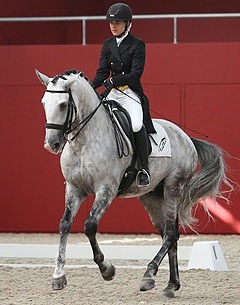
If we are training our bodies do be stronger, or leaner, or training our minds to be less impatient or more confident, it is a process. It takes patience, time, and the knowledge that going back a little doesn’t mean going all the way back to the beginning.
Sometimes we might have a break through, a moment when we feel like we are stepping to the next level, and then a week later it might seem as if we are right back to where we were before. This is the circle of life, the circle of training, and just as in training our minds or our bodies, the circle of dressage comes in waves and it is not a constant or linear pathway to Grand Prix.
A good rider will know that the problems of yesterday can be worked on and improved, but there will always be something that can return, if forgotten about. For example, you go away for a week, or your horse has to have a week off because his feet were trimmed a bit short, or he got a colic, and when you start the work again the leaning of the left rein issue rears its ugly head again. You feel disheartened because you were certain you’d fixed it, but you forget that in the circle of training the ups and downs are part of the process, and just as you solved the problem before you must do so again.
This can also apply to many different aspects of dressage training and this circle also implies that while one aspect might be strengthening, another aspect might be losing some of its lustre. Sometimes we will have a week during which the trot work feels really great, the rhythm is good, the horse is even on both reins and working over the back, and then when we ask the canter everything feels as if it goes out the window and the horse is cantering like he was two months ago. Alternatively the canter might suddenly make a rapid improvement, and the trot that before came quite naturally, seems to require all the work.
Any trainer that tells you he has a method that applies to all horses of all levels be wary about! But anyone who tells you they learn something new everyday about riding and training has probably got a lot more chance of having success in the sport of dressage.
The minute you find yourself saying, “that issue will never come back,” or "now the trot will always be easy,” or “now I’ve got the flying changes all sorted out,” or any sort of absolute remark when it comes to training, should question whether that will really help them identify what is going on.
If your horse leant on the left shoulder during a phase of his training life, you must always be aware of that habit and whether it comes creeping back in. The truth is that as a horse develops, his body changes shape, and things that he once found easy, might become more difficult, and vice versa.
The canter on my horse was always naturally his strong point. However as we started to begin the collected canter and work within collected canter, he decided that seemed a lot like hard work and would put much more effort into his trot. There was a time when the trot developed really quickly and the canter needed more time, as my horse at that point needed more strength to carry himself in a collected canter.
In the very beginning some horses like to offer a lot of action in front, knee action, and riders are sometimes criticised that the horse is hollow in the back and not engaged and active in the hindquarters. In the circle of dressage this is where the rider needs to ask the horse to take a step back, a deliberate backtrack on the circle, to allow the horse to first gain the strength behind to match the front and use his back correctly.
It’s not a straight line and if you feel as if you're right back at the beginning, don’t get disheartened or frustrated! Remember that what goes around comes around and if you got that perfect pirouette before or you had your horse straigh, or you did a super halt, you will get it again.
Just remember the steps you took before and begin again. Hopefully each time you repeat the circle, it will take a little less patience and time to get back to the spot you were at, and eventually you won’t have to do the full loop, but just a subtle reminder to keep yourself at the point that you wish to be.
by Sarah Warne